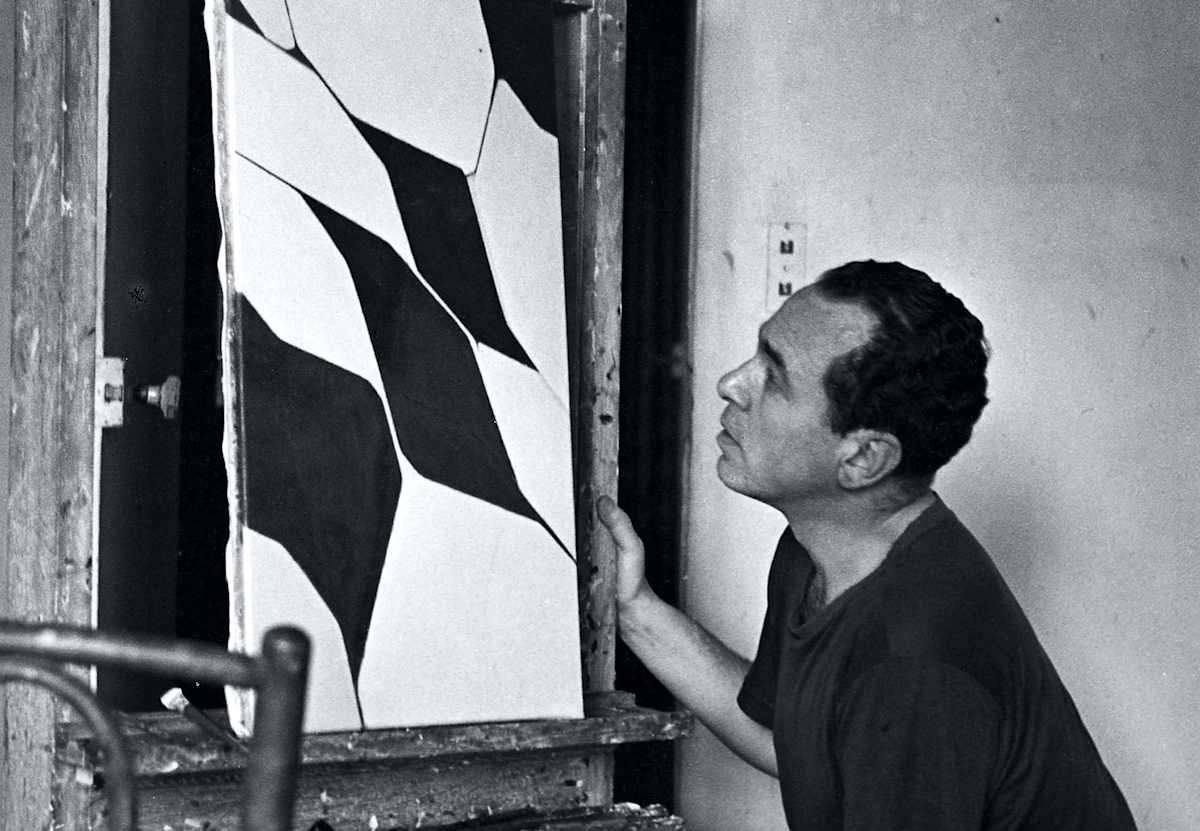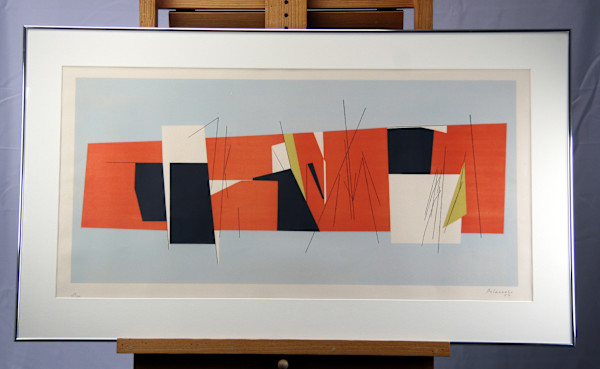
-
Artist: Pablo Palazuelo (Spanish, 1916-2007)
Pablo Palazuelo (1915–2007) was a Spanish painter and sculptor known for his abstract, geometric works that explored form, space, and the intersection between art and science. Palazuelo's artistic career spanned over six decades, and he is considered one of Spain's most important post-war artists. His work, which moved between painting, sculpture, and drawing, was deeply influenced by mathematics, philosophy, and esoteric symbolism.
Early Life and Education:
Born: October 5, 1915, in Madrid, Spain.
Education: Palazuelo initially studied architecture at the School of Architecture in Madrid and later in Oxford, England. His background in architecture strongly influenced his interest in structure and form, which would become central themes in his artistic work.
In 1939, he returned to Spain due to the outbreak of World War II and eventually shifted his focus entirely to painting and sculpture.
Artistic Style and Influences:
Abstract and Geometric Art: Palazuelo’s work is characterized by a meticulous exploration of geometric forms and abstract compositions. He was deeply interested in how shapes and patterns could evoke complex ideas and feelings. His art often appears minimalist at first glance but carries layers of mathematical precision and philosophical depth.
Influence of Science and Mathematics: Palazuelo’s fascination with geometry and mathematics, particularly non-Euclidean geometry, had a profound impact on his work. He saw art as a way of understanding the universe's hidden structures, seeking to represent the invisible forces that govern reality through abstract forms.
Esoteric and Mystical Thought: Beyond scientific inquiry, Palazuelo was also influenced by mystical and philosophical ideas. He believed in the interconnectivity of all things and sought to express this unity in his art, using symbols and forms derived from various traditions.
Major Phases and Work:
Early Abstract Period (1940s-1950s):
In the 1940s, Palazuelo became associated with the post-war abstract movement in Europe. He was heavily influenced by the work of Paul Klee, whom he admired for his balance of rationality and intuition.
During this period, Palazuelo began to gain international recognition, especially after moving to Paris in 1948. In Paris, he became connected to avant-garde circles, including exhibiting with the Galerie Maeght, a key gallery that supported modern abstract artists.
Exploration of Geometry (1960s):
In the 1960s, Palazuelo’s work became increasingly focused on geometry. His forms grew more complex, exploring space, volume, and movement through intricate, interlocking shapes. He was interested in how geometric forms could give rise to organic structures, showing the fluid relationship between nature and abstraction.
Transition to Sculpture (1970s-1980s):
While he began his career as a painter and draughtsman, Palazuelo turned to sculpture in the late 1960s and 1970s. His three-dimensional works maintained his strong interest in geometric abstraction, but now his forms occupied physical space, challenging viewers to engage with them from multiple perspectives.
His sculptures often appeared as if they were unfolding or expanding in space, further reflecting his interest in transformation and the unseen forces that shape the universe.
Notable Works:
Paintings: Some of his most notable abstract paintings include works from his early geometric period, which played with layered shapes and intersecting lines, such as the series "Macla". These works are characterized by their intricate precision and subtle play of color.
Sculptures: His transition to sculpture produced notable works like "Octaedro", where geometric shapes take on new life in space. These pieces often seem to shift and transform as viewers walk around them.
Drawings: Palazuelo was also a prolific draftsman, producing countless preparatory sketches that reveal his deep engagement with form and structure.
Philosophy and Approach:
Palazuelo saw art as a means of discovery rather than mere representation. He believed that geometric shapes and abstract forms could express the unseen, underlying realities of the universe. His work often feels like a visual translation of metaphysical and scientific ideas.
Transformation was a key concept in his work. He explored how simple geometric forms could evolve into complex patterns, reflecting his belief in the interconnectedness of all things in nature.
Recognition and Legacy:
Palazuelo was a prominent figure in the Spanish art world and received numerous awards throughout his career, including the prestigious Premio Nacional de Artes Plásticas in 1999.
His work has been exhibited extensively in Europe and the U.S., and he remains highly respected for his intellectual approach to abstraction. Major retrospectives of his work have been held at the Museo Nacional Centro de Arte Reina Sofía in Madrid and the Fondation Maeght in France.
Today, Palazuelo’s work is part of the collections of major museums, including the Tate Modern in London, the Guggenheim Museum in New York, and the Museum of Modern Art in Paris.
Legacy:
Pablo Palazuelo’s work continues to influence contemporary artists interested in abstraction, geometry, and the intersection between art and science. His commitment to exploring deep, often invisible structures through art has positioned him as one of the key figures of post-war European abstraction. Palazuelo’s work remains a profound meditation on the mysteries of form and the universal patterns that underlie reality.
Powered by Artwork Archive
